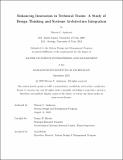| dc.contributor.advisor | Rhodes, Donna H. | |
| dc.contributor.author | Anderson, Warren V. | |
| dc.date.accessioned | 2023-11-02T20:12:53Z | |
| dc.date.available | 2023-11-02T20:12:53Z | |
| dc.date.issued | 2023-09 | |
| dc.date.submitted | 2023-10-10T21:04:41.080Z | |
| dc.identifier.uri | https://hdl.handle.net/1721.1/152747 | |
| dc.description.abstract | With increasing discoveries in technology and new emerging markets, large enterprises and agencies see a rising demand for innovation. As a result, the roles and responsibilities of technical experts, including engineers and scientists, in these organizations are growing. Technical experts are being pushed to expand their capabilities beyond solution evaluation and into divergent concept exploration space. Additional tools and skills support are needed to assist these technical experts in this new approach.
NASA's Aeronautics Research Mission Directorate (ARMD) is dedicated to transforming aviation to meet the nation's and the world's future needs. The Convergent Aeronautics Solution (CAS) project was developed to accelerate ARMD's innovation capabilities. The CAS project is designing a bespoke innovation framework that fits its culture and mission through human-centered design and leveraging tools from systems architecture to address complex societal problems through aviation. This thesis investigates how to influence the technical experts using the CAS project as a case study in addition to interviews conducted with team members.
This real-world case study provided a unique opportunity to observe a large agency. This thesis discusses three insights that emerged from this research into how to support new technical teams during ideation. First, embrace the natural tendency of technical experts to generate concepts. While systems architecture and human-centered design prescribe exploring the problem before developing concepts, it is better to make some space for the technical experts to propose ideas. Second, concept generation and the ideation process can benefit from an experienced facilitator(s) to help keep the team in a generative mindset. Teams new to the ideation process need assistance while they gain experiential learning of this new approach. Finally, this early lifecycle exploration of the problem and the stakeholder's needs can be ambiguous and challenging. The tools and methods of human-centered design and systems architecture can help structure the approach for problem formulation, interpreting the stakeholder's needs, and generating transformative solutions. | |
| dc.publisher | Massachusetts Institute of Technology | |
| dc.rights | In Copyright - Educational Use Permitted | |
| dc.rights | Copyright retained by author(s) | |
| dc.rights.uri | https://rightsstatements.org/page/InC-EDU/1.0/ | |
| dc.title | Enhancing Innovation in Technical Teams: A Study of Design Thinking and Systems Architecture Integration | |
| dc.type | Thesis | |
| dc.description.degree | S.M. | |
| dc.contributor.department | System Design and Management Program. | |
| dc.identifier.orcid | 0009-0008-6867-2491 | |
| mit.thesis.degree | Master | |
| thesis.degree.name | Master of Science in Engineering and Management | |
